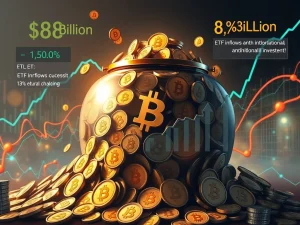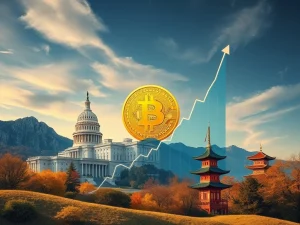Urgent Warning: Paolo Ardoino Exposes Shocking Plot to ‘Kill’ Tether

In a startling revelation that has sent ripples through the cryptocurrency world, Paolo Ardoino, the CTO of Tether, has made explosive claims about a concerted effort to undermine and potentially ‘kill’ Tether (USDT). According to Ardoino, this alleged campaign is being orchestrated by competitors and politicians, creating a sense of urgency and alarm within the crypto community. Is this a genuine threat to the world’s leading stablecoin, or just industry noise? Let’s dive deep into this developing story.
Who is Paolo Ardoino and Why His Words on Tether Matter?
Before we dissect the gravity of these accusations, it’s crucial to understand who Paolo Ardoino is and why his statements carry significant weight. As the Chief Technology Officer of Tether, and also a key figure at Bitfinex, Ardoino is deeply entrenched in the crypto ecosystem. His insights into market dynamics, competitive pressures, and regulatory challenges are invaluable. When Ardoino speaks about Tether, the crypto world listens because he is at the heart of its operations, intimately aware of the internal and external forces shaping its trajectory.
Ardoino’s recent pronouncements, shared on X (formerly Twitter), paint a picture of a company under siege. He alleges that meetings among competitors and politicians are consistently centered around the intention to ‘kill Tether’. This isn’t just about fair competition; it’s portrayed as a deliberate and potentially malicious campaign against the dominant stablecoin. But what could be the motives behind such an aggressive stance?
The Alarming Allegations: A Plot to ‘Kill’ Tether?
Ardoino’s words are stark: “Every single business or political meeting that they have culminates with this intent.” This is not a casual observation but a serious indictment. Let’s break down what this could imply:
- Competitive Pressure: Tether’s dominance in the stablecoin market is undeniable. Competitors vying for market share might see undermining Tether as a strategic move to elevate their own positions.
- Regulatory Scrutiny: Politicians and regulatory bodies worldwide are increasingly focused on crypto regulation. Tether, being the largest stablecoin, naturally falls under intense scrutiny. Some political agendas might view limiting or controlling Tether as necessary for broader financial stability or control.
- De-risking Concerns: Given the interconnectedness of Tether with the wider crypto market, some stakeholders might genuinely believe that reducing Tether’s influence is necessary to de-risk the entire ecosystem.
However, the term “kill Tether” is exceptionally strong. It suggests not just regulation or competition, but a deliberate attempt to dismantle or severely cripple Tether’s operations. Is this hyperbole, or is there genuine cause for such concern? The crypto community is now keenly watching for further developments and evidence to support these claims.
Why Target Tether? Understanding the Stablecoin Giant
To grasp why Tether might be a target, we need to understand its significance. USDT is not just another cryptocurrency; it’s the backbone of much of the crypto trading ecosystem. Here’s why Tether’s position makes it both powerful and potentially vulnerable:
| Aspect | Significance of Tether (USDT) |
|---|---|
| Market Capitalization | Dominates the stablecoin market with a massive market cap, far exceeding competitors. |
| Trading Volume | Used in countless trading pairs across exchanges, facilitating liquidity and price discovery. |
| On-Ramp/Off-Ramp | Serves as a crucial bridge between fiat currencies and the crypto world. |
| Ecosystem Integration | Deeply integrated into DeFi protocols, lending platforms, and various crypto services. |
Tether’s ubiquity is both its strength and potential weakness. Its failure or significant disruption could have cascading effects throughout the crypto market. This inherent systemic importance makes it a focal point for both supporters and detractors. For competitors, dismantling such a dominant player could open up vast opportunities. For regulators, controlling or mitigating risks associated with such a large entity becomes paramount.
USDT Under Scrutiny: Navigating Crypto Regulation
The landscape of crypto regulation is constantly evolving, and stablecoins, especially USDT, are at the forefront of regulatory discussions. Governments and financial watchdogs worldwide are grappling with how to oversee these digital assets. Key regulatory concerns surrounding stablecoins include:
- Reserves and Backing: Ensuring stablecoins are truly backed by reserves matching their circulating supply. Tether’s reserves have been a subject of intense debate and scrutiny over the years.
- Anti-Money Laundering (AML) and KYC: Compliance with AML and Know Your Customer regulations to prevent illicit activities.
- Financial Stability Risks: Assessing the potential systemic risks that large stablecoins could pose to the broader financial system.
- Consumer Protection: Safeguarding users from potential risks associated with stablecoin usage.
These regulatory pressures are not necessarily attempts to “kill” Tether, but rather to establish a framework for responsible operation within the financial system. However, overly stringent or poorly designed regulations could inadvertently stifle innovation and harm the crypto ecosystem. Ardoino’s claims suggest a more aggressive, potentially politically motivated agenda beyond just prudent regulation.
Competitors and Politicians: Who are the Alleged Threats?
While Ardoino’s statement is direct, it lacks specific names. Who are these competitors and politicians allegedly aiming to “kill” Tether? Speculation is rife, but let’s consider potential categories:
- Competitor Stablecoin Issuers: Companies behind other stablecoins like USDC, DAI, or BUSD (though BUSD is now ceasing issuance). These entities naturally compete for market share and user adoption.
- Traditional Financial Institutions: Banks and legacy financial players who may see crypto, and stablecoins in particular, as a challenge to their established dominance.
- Regulatory Bodies and Government Agencies: While some regulators aim for balanced oversight, others might harbor a more adversarial stance towards crypto, potentially influenced by traditional financial lobbying or political agendas.
- Political Opponents: In certain political climates, cryptocurrencies and companies associated with them can become targets for political maneuvering or ideological opposition.
Without concrete evidence, identifying specific actors remains speculative. However, the potential motives are clear: market dominance, regulatory control, and political influence. Ardoino’s warning serves as a call to the crypto community to be vigilant and prepared for potential challenges.
Conclusion: Navigating the Storm Clouds Over Tether
Paolo Ardoino’s alarming statement has undoubtedly ignited a firestorm of discussion and speculation. Whether these alleged attempts to “kill” Tether are real, exaggerated, or misconstrued, the message is clear: Tether faces significant external pressures. For the crypto community, this serves as a crucial reminder of the ongoing battles for legitimacy, market share, and regulatory acceptance within the financial world.
As the story unfolds, it will be vital to watch for concrete evidence, regulatory developments, and responses from both Tether and its alleged adversaries. One thing is certain: the future of Tether, and potentially the broader stablecoin market, could hinge on the outcomes of these unfolding events. Stay tuned for further updates as this urgent situation develops.










